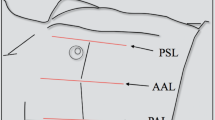Abstract
Introduction
The clinical significance of extended Focused Assessment with Sonography for Trauma (EFAST) for diagnosis of pneumothorax is not well defined.
Objectives
To investigate the utility of EFAST in blunt chest trauma (BCT) patients.
Study design
A single blinded, prospective study. Participants: All patients admitted with BCT (2011–2013).
Settings
Level 1 trauma center in Qatar.
Procedures and outcome measures
Patients were screened by EFAST and results were compared to the clinical examination (CE) and chest X-ray (CXR). Chest-computed tomography (CT) scoring system was used to confirm and measure the pneumothorax. Diagnostic accuracy of diagnostic modalities of pneumothorax was measured using sensitivity, specificity, predictive values (PVs), and likelihood ratio.
Results
A total of 305 BCT patients were included with median age of 34 (18–75). Chest CT was positive for pneumothorax in 75 (24.6 %) cases; of which 11 % had bilateral pneumothorax. Chest CT confirmed the diagnosis of pneumothorax in 43, 41, and 11 % of those who were initially diagnosed by EFAST, CE, and CXR, respectively. EFAST was positive in 42 hemithoraces and its sensitivity (43 %) was higher in comparison to CXR (11 %). Positive and negative PVs of EFAST were 76 and 92 %, respectively. The frequency of missed cases by CXR was higher in comparison to EFAST and CE. The lowest median score of missed pneumothorax was observed by EFAST.
Conclusion
EFAST can be used as an efficient triaging tool in BCT patients to rule out pneumothorax. Based on our analysis, we would recommend EFAST as an adjunct in ATLS algorithm.





Similar content being viewed by others
References
Ascher WM, Parvin S, Virgilio RW (1976) Echographic evaluation of splenic injury after blunt trauma. Radiology 118:411–415
Kristensen JK, Buemann B, Keuhl E (1971) Ultrasonic scanning in the diagnosis of splenic haematomas. Acta Chir Scand 137:653–657
Rozycki GS, Ochsner MG, Schmidt JA, Frankel HL, Davis TP, Wang D et al (1995) A prospective study of surgeon-performed ultrasound as the primary adjuvant modality for injured patient assessment. J Trauma 39:492–498
Rozycki GS, Shackford SR (1996) Ultrasound, what every trauma surgeon should know. J Trauma 40:1–4
American College of Surgeons Committee on Trauma (1997) Advanced Trauma Life Support Course for Physicians. American College of Surgeons, Chicago
Di Bartolomeo S, Sanson G, Nardi G, Scian F, Michelutto V, Lattuada L (2001) A population-based study on pneumothorax in severely traumatized patients. J Trauma 51:677–682
Wilkerson RG, Stone MB (2010) Sensitivity of bedside ultrasound and supine anteroposterior chest radiographs for the identification of pneumothorax after blunt trauma. Acad Emerg Med 17:11–17
Ball CG, Kirkpatrick AW, Laupland KB, Fox DL, Litvinchuk S, Dyer DM, Anderson IB, Hameed SM, Kortbeek JB, Mulloy R (2005) Factors related to the failure of radiographic recognition of occult posttraumatic pneumothoraces. Am J Surg 189:541–546
Omar HR, Abdelmalak H, Mangar D, Rashad R, Helal E, Camporesi EM (2010) Occult pneumothorax, revisited. J Trauma Manag Outcomes 29(4):12
Husain LF, Hagopian L, Wayman D, Baker WE, Carmody KA (2012) Sonographic diagnosis of pneumothorax. J Emerg Trauma Shock 5:76–81
de Moya MA, Seaver C, Spaniolas K, Inaba K, Nguyen M, Veltman Y, Shatz D, Alam HB, Pizano L (2007) Occult pneumothorax in trauma patients: development of an objective scoring system. J Trauma 63:13–17
Rhea JT, Novelline RA, Lawrason J, Sackoff R, Oser A (1989) The frequency and significance of thoracic injuries detected on abdominal CT scans of multiple trauma patients. J Trauma. 29:502–505
Ball CG, Hameed SM, Evans D, Kortbeek JB, Kirkpatrick AW, Canadian Trauma Trials Collaborative (2003) Occult pneumothorax in the mechanically ventilated trauma patient. Can J Surg 46:373–379
Zhang M, Liu ZH, Yang JX, Gan JX, Xu SW, You XD, Jiang GY (2006) Rapid detection of pneumothorax by ultrasonography in patients with multiple trauma. Crit Care 10:R112
Wernecke K, Galanski M, Peters PE, Hansen J (1987) Pneumothorax: evaluation by ultrasound–preliminary results. J Thorac Imaging 2:76–78
Dulchavsky SA, Schwarz KL, Kirkpatrick AW et al (2001) Prospective evaluation of thoracic ultrasound in the detection of pneumothorax. J Trauma 50:201–205
Knudtson JL, Dort JM, Helmer SD, Smith RS (2004) Surgeon-performed ultrasound for pneumothorax in the trauma suite. J Trauma 56:527–530
Kirkpatrick AW, Sirois M, Laupland KB, Liu D, Rowan K, Ball CG, Hameed SM, Brown R, Simons R, Dulchavsky SA, Hamiilton DR, Nicolaou S (2004) Hand-held thoracic sonography for detecting post-traumatic pneumothoraces: the Extended Focused Assessment with Sonography for Trauma (EFAST). J Trauma 57:288–295
Soldati G, Testa A, Sher S et al (2008) Occult traumatic pneumothorax: diagnostic accuracy of lung ultrasonography in the emergency department. Chest 133:204–211
Alsalim W, Lewis D (2009) Towards evidence based emergency medicine: best BETs from the Manchester Royal Infirmary. BET 1: is ultrasound or chest X ray best for the diagnosis of pneumothorax in the emergency department? Emerg Med J. 26:434–435
Nandipati KC, Allamaneni S, Kakarla R, Wong A et al (2012) Extended focused assessment with sonography for trauma (EFAST) in the diagnosis of pneumothorax: experience at a community based level I trauma center. Chest 141:703–708
Acknowledgments
We thank all the Trauma surgery staff, database registry for their kind cooperation. All authors read the manuscript and approved it and had no financial issues to disclose. Medical Research Center (IRB# 9055/09) at Hamad Medical Corporation, Qatar has approved the study.
Author information
Authors and Affiliations
Corresponding author
Additional information
The present study has been accepted for presentation in part in The Trauma Association of Canada Annual Scientific Meeting, April 10–11, 2014 at the Centre Mont-Royal in Montreal, QC, Canada.
Rights and permissions
About this article
Cite this article
Abdulrahman, Y., Musthafa, S., Hakim, S.Y. et al. Utility of Extended FAST in Blunt Chest Trauma: Is it the Time to be Used in the ATLS Algorithm?. World J Surg 39, 172–178 (2015). https://doi.org/10.1007/s00268-014-2781-y
Published:
Issue Date:
DOI: https://doi.org/10.1007/s00268-014-2781-y




